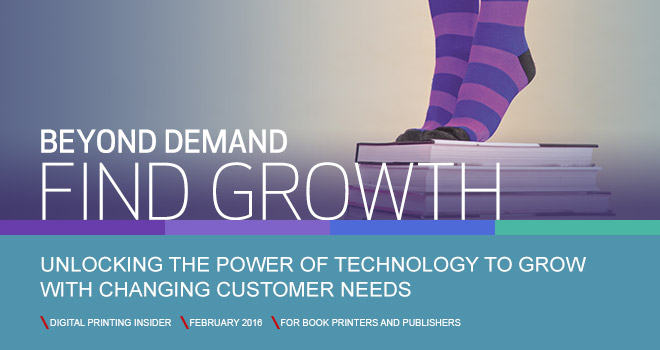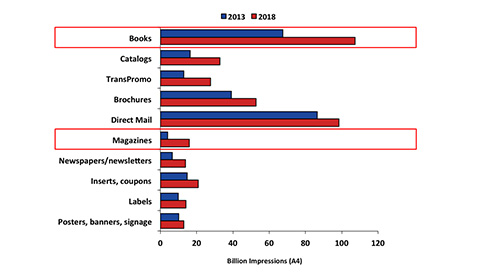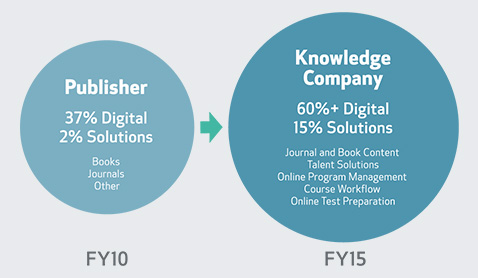The Future of Books and Magazines: Research Highlights and Trends
The future is changing for books and magazines. Print remains the number one source of revenue for most publishers, but what are the future trends for print in the industry? In the Canon Solutions America-sponsored webinar entitled Books and Magazines: What Does the Future Hold? presented by Book Business and Publishing Executive magazines, InfoTrends Group Director Barb Pellow shares results from a survey of 103 book and magazine publishers about today’s changing dynamics.
Joining Pellow in this session are Lynn Terhune, Global Digital Print Manager of Strategic Sourcing & Procurement at Wiley, and Amanda Jennison, Marketing Director at Bates Creative. Throughout the webinar, these speakers cover a series of topics including the status of printed communications, how e-book production and e-editions for magazines are maturing, the future of the industry, the role of mobile apps, trends for current and upcoming distribution channels, and industry perspectives on how these changes will impact businesses.
At the beginning of the webinar, Pellow states, “Books, magazines, newsletters, and newspapers are all being redefined … and this is all being driven by technology!” According to InfoTrends’ research and forecast data, printed applications that were once dominated by offset technologies are now migrating to digital print production technology and experiencing rapid growth. For example, InfoTrends projects that by 2018, almost 40 billion book pages will move from traditional offset technology to on-demand printing. Similar changes are also occurring in the newspaper and magazine markets.
According to Pellow, the evolution doesn’t stop there. She elaborates, “There is even more that is taking place in today’s market. Technology has changed the way that content is created, formatted, designed, stored, printed, digitalized, distributed, and sold. As a result, new content products are being created, new channels are emerging in the marketplace, and revenue shifts are taking place among all the different formats.” The bottom line is that these changes are affecting everyone in the print and publishing worlds.
Pellow continues, “Consumers’ expectations are changing. Today’s readers want books and magazines that are interactive, engaging, affordable, and always available.” During the webinar introduction, Pellow discusses market trends, offering financial reflections and discussing specific growth opportunities for publishers.
Next, Lynn Terhune shares her perspective on the changes within our marketplace. Terhune describes Wiley as a content company that is changing into a “knowledge company” that provides a growing number of online services and solutions as well as printed and electronic content for businesses and publishers. Digital services at Wiley have experienced significant growth, and the company’s offerings now include a variety of services that “simply didn’t exist three to five years ago,” she notes.
Approximately 45% of Wiley’s portfolio comes from digital services, while the balance of revenues can be attributed to printed publications. According to findings from the Global Education Custom product and business unit, students still prefer print. Terhune elaborates, “We’re still printing because of these preferences, but we’ve got a number of other product offerings combined with the traditional printed materials. These include bind-in access cards, e-content, or e-mash ups (which are a combination of Wiley text and professor content). We’re also providing customer products such as a paperback version of a binder-ready product, and complementary copies that use variable data printing to print the professor’s name onto the cover.”
Terhune outlines how her company has used digital printing technology with its on-demand print services and inventory management systems to print smarter, be more flexible, and deliver products more efficiently. To Terhune, the current state and future potential of the books market contains a variety of buzzwords — and many of these are being put to use. “The possibilities really are endless,” she notes. “The future will just have more of everything.”
Later, Amanda Jennison joins the presentation to discuss how the team at Bates Creative has redefined its business as a storyteller by design through repurposing content across multiple platforms. In an effort to balance the decline in print, the company started working with digital content design solutions prior to Apple’s introduction of its first iPad nearly six years ago. Jennison explains, “We knew that digital would represent a big change for our clients, but now it represents about 40% of the work that comes in for us — right behind the 47% that is attributable to print.”
Regarding the changing dynamics in the world of magazines, Jennison notes, “There’s no question that we’re seeing a shift in the marketplace and with our clients.” During the webinar, Jennison highlights several trends and statistics to support her claims. She then goes into detail about what it all means and how Bates Creative is responding.
According to Jennison, the most important part of a publisher’s strategy is to keep up with readers’ changing demands. Audience and analytics are at the core of Jennison’s insights. She states, “It’s all about understanding your audiences and how they fit into these trends.” At Bates, Jennison stays on top of clients’ digital success by analyzing research reader data and other analytics. She continues, “It’s so important to take the time to get to know your readers — then you can start strategizing.”
Take the time to join Pellow and this expert panel as they provide insight on today’s specific challenges, offer compelling evidence about future directions, and provide advice on how to effectively embrace the opportunities of tomorrow.


